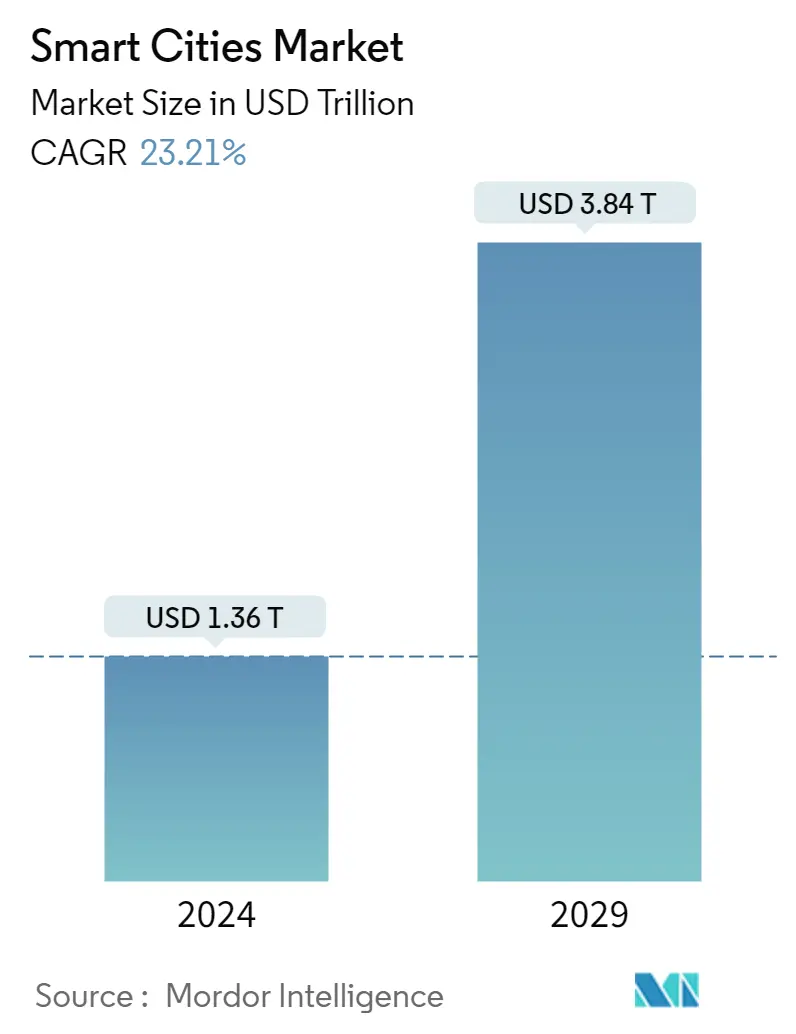Market Size of Smart Cities Industry

| Study Period | 2019 - 2029 |
| Market Size (2024) | USD 1.36 Trillion |
| Market Size (2029) | USD 3.84 Trillion |
| CAGR (2024 - 2029) | 23.21 % |
| Fastest Growing Market | Asia-Pacific |
| Largest Market | Europe |
Major Players
*Disclaimer: Major Players sorted in no particular order |
Smart Cities Market Analysis
The Smart Cities Market size is estimated at USD 1.36 trillion in 2024, and is expected to reach USD 3.84 trillion by 2029, growing at a CAGR of 23.21% during the forecast period (2024-2029).
The market numbers in the study indicate the revenue generated from various types of solutions such as smart mobility management, smart public safety, smart healthcare, smart building, smart utilities, smart security, smart education, and other solutions.
- A smart city is an urban area that makes use of cutting-edge technologies such as artificial intelligence (AI), the Internet of Things (IoT), cloud storage, big data, and data analytics to gather and analyze utilization data and use the insights gained from them to manage resources, services, and assets effectively. Growing government measures to address urbanization and overpopulation and the growing need for resource management for sustainable development are driving growth in the smart cities industry.
- The increased adoption of the Internet and the Internet of Things propel the growth of smart cities and platforms worldwide. It is expected that by the next three years, there will be more than 26 smart cities, with the majority existing in North America and Europe, providing a major drive to the AI and IoT sensors for adoption in smart cities.
- From the first telegraphic fire alarms to radios and dash cams, public safety agencies-law enforcement, fire, EMS, and emergency management-have always been early adopters of the newest technologies. Increasing smart device networks and the development of artificial intelligence are turning public safety technology today from a necessary toolkit into an independent partner that can take action to keep the public safe.
- Various organizations in the studied market are focusing on strategic partnerships, investments, and expansion to help countries adopt smart solutions. For instance, in October 2022, Nokia announced a strategic partnership with Nedaa, the security network provider of the Dubai government, to explore innovative 5G network slicing for public safety use and smart cities. Similarly, in October 2022, Siemens AG announced to invest EUR 5 billion ( USD 5.41 billion) in India to support the country's rapid urbanization and energy transformation.
- Moreover, in February 2023, Companies from Singapore and Asia Pacific, such as Daily Life Renewable Energy, Mdesigns Solutions, Biodsg, and Graymatics, among others, will collaborate with United Arab Emirates (UAE) firms to develop smart city pilot projects in Abu Dhabi. These companies will collaborate with local entities such as Adnoc and the rest to develop resilient cities by transforming street lighting and increasing the energy efficiency of Al Dannah City buildings.
- Data security is the prime concern of every government incorporating the smart city plan, as it is vital in industries such as BFSI, retail, healthcare, and others, owing to the sensitive nature of the data. IoT platforms used for smart cities are experiencing high adoption rates due to IoT demand. This increasing use of these platforms for smart cities across various verticals has increased the vulnerabilities of these systems to data breaches. The need for a uniform security platform is increasing, with many providers offering multiple solutions.
- COVID-19 propelled the development of smart cities. Smart city infrastructure helped government agencies avoid the dangerous COVID-19 virus. Post-COVID-19, the government has also been investigating the potential for implementing some smart city technologies to increase urban resilience in times of crisis. The government of Singapore has acknowledged the significance of accelerating the nation's degree of digitization across industries.
Smart Cities Industry Segmentation
A smart city is an urban area that uses different types of electronic methods and sensors to collect data. Insights gained from that data are used to manage assets, resources, and services efficiently. This data is used to improve operations across the city.
The smart city market report is segmented by solution (smart mobility management, smart public safety, smart healthcare, smart building, smart utilities, smart security, smart education) and by geography (North America, Europe, Asia-Pacific, Latin America, Middle East and Africa). The market sizes and forecasts are provided in terms of value (USD) for all the above segments.
| By Solution | |
| Smart Mobility Management | |
| Smart Public Safety | |
| Smart Healthcare | |
| Smart Building | |
| Smart Utilities | |
| Smart Security | |
| Smart Education | |
| Other Solutions |
| By Geography | ||||||||
| ||||||||
| ||||||||
| ||||||||
| ||||||||
|
Smart Cities Market Size Summary
The smart cities market is poised for significant expansion, driven by the integration of advanced technologies such as artificial intelligence, the Internet of Things, and big data analytics. These technologies enable urban areas to optimize resource management, enhance public safety, and improve service delivery. The increasing urbanization and the need for sustainable development are key factors propelling the market's growth. Governments worldwide are investing in smart city initiatives to address challenges related to overpopulation and resource management. The adoption of IoT and connected devices is a major trend, with municipalities implementing smart solutions in areas like transportation, public safety, and energy efficiency. Strategic partnerships and investments by major players further bolster the market, as companies seek to leverage innovative technologies to gain a competitive edge.
The market landscape is characterized by a semi-consolidated structure, with leading companies such as ABB Ltd, Cisco Systems Inc., and IBM Corporation actively engaging in partnerships, acquisitions, and technological innovations. These efforts aim to enhance product offerings and meet the growing demand for smart city solutions. Regions like Asia-Pacific, particularly China, are at the forefront of smart city development, supported by government policies and public-private partnerships. The market's growth is also fueled by the increasing importance of data security, as smart city platforms become more prevalent across various sectors. As the market evolves, the focus on sustainable and efficient urban infrastructure continues to drive investments and technological advancements, positioning smart cities as a pivotal component of future urban development.
Smart Cities Market Size - Table of Contents
-
1. MARKET INSIGHTS
-
1.1 Market Overview
-
1.2 Industry Value Chain Analysis
-
1.3 Industry Attractiveness - Porter's Five Forces Analysis
-
1.3.1 Bargaining Power of Suppliers
-
1.3.2 Bargaining Power of Buyers
-
1.3.3 Threat of New Entrants
-
1.3.4 Threat of Substitutes
-
1.3.5 Intensity of Competitive Rivalry
-
-
-
2. MARKET SEGMENTATION
-
2.1 By Solution
-
2.1.1 Smart Mobility Management
-
2.1.2 Smart Public Safety
-
2.1.3 Smart Healthcare
-
2.1.4 Smart Building
-
2.1.5 Smart Utilities
-
2.1.6 Smart Security
-
2.1.7 Smart Education
-
2.1.8 Other Solutions
-
-
2.2 By Geography
-
2.2.1 North America
-
2.2.1.1 United States
-
2.2.1.2 Canada
-
-
2.2.2 Europe
-
2.2.2.1 United Kingdom
-
2.2.2.2 Germany
-
2.2.2.3 France
-
2.2.2.4 Sweden
-
2.2.2.5 Rest of Europe
-
-
2.2.3 Asia-Pacific
-
2.2.3.1 China
-
2.2.3.2 Japan
-
2.2.3.3 India
-
2.2.3.4 Australia
-
2.2.3.5 South Korea
-
2.2.3.6 Rest of Asia-Pacific
-
-
2.2.4 Latin America
-
2.2.4.1 Mexico
-
2.2.4.2 Brazil
-
2.2.4.3 Argentina
-
2.2.4.4 Rest of Latin America
-
-
2.2.5 Middle East and Africa
-
2.2.5.1 Saudi Arabia
-
2.2.5.2 United Arab Emirates
-
2.2.5.3 South Africa
-
2.2.5.4 Rest of Middle East and Africa
-
-
-
Smart Cities Market Size FAQs
How big is the Smart Cities Market?
The Smart Cities Market size is expected to reach USD 1.36 trillion in 2024 and grow at a CAGR of 23.21% to reach USD 3.84 trillion by 2029.
What is the current Smart Cities Market size?
In 2024, the Smart Cities Market size is expected to reach USD 1.36 trillion.

